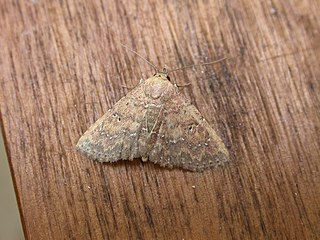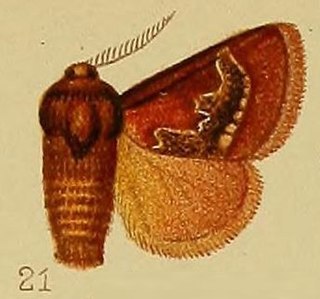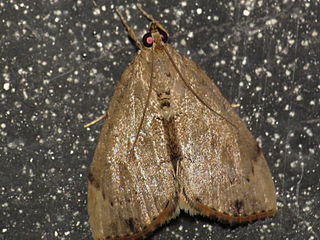Related Research Articles

Agylla is a genus of moths in the subfamily Arctiinae. The genus was erected by Francis Walker in 1854.

Utetheisa pulchelloides, the heliotrope moth, is a moth of the family Erebidae. It is found in the Indo-Australian region including Borneo, Hong Kong, New Zealand, Papua, Seychelles and most of Australia. The species was first described by George Hampson in 1907.
Thesaurica is a genus of moths of the family Crambidae.
Phobolosia is a genus of moths in the family Erebidae. The genus was erected by Harrison Gray Dyar Jr. in 1908.

Tathorhynchus is a monotypic moth genus in the family Erebidae erected by George Hampson in 1894. Its only species, Tathorhynchus exsiccata, the Levant blackneck or double-spotted snout, was first described by Julius Lederer in 1855. The nominate form is found on the Canary Islands and in North Africa, tropical Asia and tropical Africa. It has been introduced in Dominica and Argentina. Subspecies Tathorhynchus exsiccata fallax is found in the northern half of Australia, as well as Norfolk Island and New Zealand.

Thyas coronata is a species of moth of the family Noctuidae first described by Johan Christian Fabricius in 1775. It is found from the Indo-Australian tropics of southern China, Taiwan, Japan, Nepal, India, Sri Lanka to Micronesia and the Society Islands.
Ophiusa disjungens, the guava moth, is a moth of the family Erebidae. The species was first described by Francis Walker in 1858. It is found in south-east Asia and the south Pacific, including Thailand, Japan, Tonga and New South Wales and Queensland. The adult is a fruit piercer.

Sasunaga tenebrosa is a moth of the family Noctuidae first described by Moore in 1867. It is found from the Indian subregion, Sri Lanka to Sundaland, the Philippines and Sulawesi.
Trichoplusia lectula is a moth of the family Noctuidae first described by Francis Walker in 1858. It is found throughout Asia, including the Indian subregion, Sri Lanka, Thailand, Borneo, Java, Japan, as well as Western Australia and Queensland.

Platyja umminia is a species of moth of the family Noctuidae first described by Pieter Cramer in 1780. It is found from the Indo-Australian tropics of China, Japan, India, Sri Lanka, Myanmar to New Guinea and Queensland. It is also present on Guam. Adults have been recorded piercing fruit in Thailand and Guam.

Hypocala deflorata is a moth of the family Erebidae. It was first described by Johan Christian Fabricius in 1794. It is widespread from India, Sri Lanka to Africa and to Australia and many Pacific islands. Records include China, Borneo, Queensland, Vanuatu, New Caledonia, Rotuma, Fiji, Samoa, Hawaii, Norfolk Island and New Zealand.

Tiracola plagiata, the cacao armyworm, is a moth of the family Noctuidae. The species was first described by Francis Walker in 1857. It is found from south-east Asia, South India, Sri Lanka, Myanmar to the South Pacific Islands, including the northern two-thirds of Australia.

Serrodes campana is a species of moth of the family Erebidae first described by Achille Guenée in 1852. It is found from the Indo-Australian tropics to eastern Australia, Fiji, Samoa and New Caledonia. It is also present in Japan, Korea and Sri Lanka. The adult is a fruit piercer, but also feeds on flower nectar.

Cerynea trogobasis is a species of moth of the family Erebidae first described by George Hampson in 1910. It is found in Queensland in Australia and the Kai Islands of Indonesia.

Plusiodonta coelonota, the snake vine moth, is a moth of the family Erebidae. The species was first described by Vincenz Kollar in 1844. It is found from India, Sri Lanka, Myanmar, Andaman Islands, Australia, Papua New Guinea, to South and South-East Asia.

Miresa is a genus of moths in the family Limacodidae described by Francis Walker in 1855.

Crocidolomia suffusalis, the croci, is a moth in the family Crambidae. It was described by George Hampson in 1891. It is found in south-east Asia, where it has been recorded from India, Sri Lanka, China, Thailand, Malaysia, Java, Bali, Borneo, the Philippines and Taiwan. It is also present in New Guinea and Australia, where it has been recorded from Queensland and New South Wales.
Achyra nigrirenalis is a moth in the family Crambidae. It was described by George Hampson in 1913. It is found in Australia, where it has been recorded from Western Australia, the Northern Territory, Queensland and South Australia.
Anania perflavalis is a moth in the family Crambidae. It was described by George Hampson in 1913. It is found in Australia, where it has been recorded from Queensland and New South Wales.
References
- ↑ Nuss, M.; et al. (2003–2014). "GlobIZ search". Global Information System on Pyraloidea. Retrieved 15 July 2014.
- ↑ Herbison-Evans, Don & Crossley, Stella (16 March 2012). "Thesaurica argentifera (Hampson, 1913)". Australian Caterpillars and their Butterflies and Moths. Retrieved 2 November 2018.
| This Odontiinae-related article is a stub. You can help Wikipedia by expanding it. |